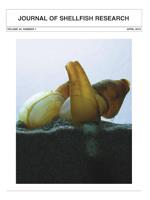Developmental larval stages of the geoduck Panopea globosa (Dall, 1898) are described for the first time. Growth rate, survival, and the length—size relationship were also assessed at 22°C in five independently reared cohorts. Clearance rates (CR), ingestion rates (IR), dry weight, and organic weight of select larval stages were quantified in two additional runs. Clearance rates and IR were evaluated as a function of cell concentration (50, 100, 200 and 300 cells/µL) of the chrysophyte Isochrysis sp. (clone T-ISO) using static systems. Conspicuous larval stages appeared after 20 h (trochophore), 24 h (straight hinge or “D”), 5–6 day (early umboned), 9–10 days (intermediate umboned), 11–12 days (late umboned), and 12–14 days (pediveliger). The larval period for P. globosa lasted between 12 days and 14 days, and the shell length recorded at settlement ranged from 332–356 µm (mean, 343 ± 4.2 µm). The overall average gross growth rate of the five larval cohorts was ∼20 µm/day. The relationship between larval shell length (in micrometers) and organic weight (in micrograms) followed a power function with an exponent value of 2.43, whereas the relationship between dry weight and organic weight was linear. Survival rate was approximately 50% in three larval cohorts and 20% in two cohorts. Clearance rates were inversely related to microalgal concentration regardless of larval size, and ranged from 0.3–1.5 µL/h (D larvae) to 15–59 µL/h (pediveliger, 330µm). On the other hand, IR increased with increasing algal concentration, and reached maximum values at 200 cells/µL, except in D-hinge larvae, which exhibited a maximum IR at all concentrations tested. At the highest concentration (300 cells/µL), premetamorphic larvae inhibited their IR. Overall, IR increased from 57–85 cells/h (D-hinge larvae) to 40- or 50-fold when larvae reached the premetamorphic stage. The current study revealed that P. globosa has a short larval period and high survival rate, and withstands a wide range of food concentrations without inhibiting its IR. Therefore, this species appears to be an excellent candidate for hatchery production.
How to translate text using browser tools
1 March 2015
Growth, Survival, and Feeding Rates for the Geoduck Panopea globosa During Larval Development
Alejandra Ferreira-Arrieta,
Zaul García-Esquivel,
Marco A. González-Gómez,
Enrique Valenzuela-Espinoza
ACCESS THE FULL ARTICLE

Journal of Shellfish Research
Vol. 34 • No. 1
March 2015
Vol. 34 • No. 1
March 2015
feeding rates
geoduck
growth
ingestion rate
larvae
Panopea globosa




